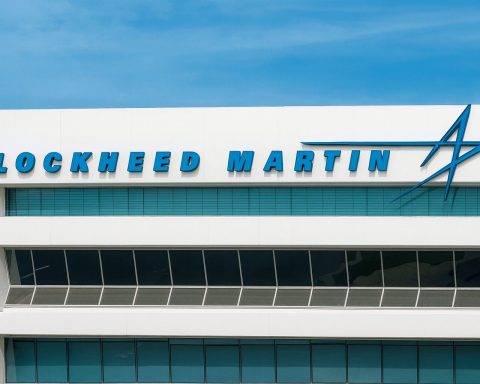Lockheed Martin stock heads into the new trading week sitting in the middle of its 52‑week range, with Wall Street trying to reconcile record backlogs and strong demand with lingering program and budget worries.
As of the last U.S. market close on Friday, November 21, 2025, Lockheed Martin Corporation (NYSE: LMT) finished at $460.78, down about 1.6% on the day and valuing the defense giant at roughly $107 billion. [1] The shares are about 15.6% below their 52‑week high of $546 and roughly 12.4% above the 52‑week low of $410.11, based on recent quote data. [2]
Despite delivering earnings beats and raising its 2025 outlook, Lockheed Martin stock has underperformed both its industry and the broader market over the past year, setting up Monday, November 24, 2025, as another test of whether investors are ready to rotate back into the name.
Lockheed Martin stock price and performance heading into today
Recent quote data show:
- Last close: $460.78
- Previous close: $468.26
- Day’s range (Friday): $459.96 – $469.40
- 52‑week range: $410.11 – $546.00
- Market cap: ≈ $106–107 billion
- Dividend: $13.80 per share annually (quarterly $3.45), implying a yield of about 3.0% at current prices
- Valuation: trailing P/E ~25.8; forward P/E ~16.6 [3]
On a total-return basis (price plus reinvested dividends), Lockheed Martin is down about 3.1% year‑to‑date and 12.6% over the past 12 months as of November 21, 2025, while still showing a 42% five‑year total return. [4] Those numbers are solid in absolute terms but notably weaker than many large aerospace and defense peers.
A recent Barron’s analysis noted that as of mid‑November, Lockheed shares were down roughly 4% year‑to‑date and about 13% over 12 months, while a leading U.S. aerospace & defense ETF had gained more than 40% in the same period. [5] That underperformance, despite robust fundamentals, is a key part of the current investment debate around LMT.
Q3 2025 earnings: record backlog and raised guidance
Lockheed Martin’s latest earnings report, released on October 21, 2025, is central to understanding the stock today.
Headline numbers, Q3 2025:
- Revenue: $18.6 billion, up about 9% year‑over‑year and above analyst expectations in the $18.4–18.6 billion range. [6]
- EPS: $6.95, up from $6.80 a year earlier and comfortably ahead of the roughly $6.3 consensus estimate. [7]
- Record backlog: about $179 billion, equal to more than 2.5 years of sales at the current run‑rate. [8]
- Cash generation: cash from operations of $3.7 billion and free cash flow of $3.3 billion in the quarter. [9]
Management responded by raising full‑year 2025 guidance:
- Revenue: $74.25–$74.75 billion
- EPS: $22.15–$22.35 per share [10]
The earnings strength was broad‑based:
- Aeronautics (home of the F‑35 fighter jet) grew sales 12% to $7.26 billion, driven by higher F‑35 deliveries and support work. [11]
- Missiles and Fire Control sales climbed 14% to $3.62 billion on higher production of precision‑strike and air & missile defense systems (JASSM, LRASM, PAC‑3, etc.). [12]
- Rotary and Mission Systems revenue held around $4.37 billion, with strong Sikorsky helicopter demand offsetting softer ship systems. [13]
- Space grew 9% to $3.36 billion, helped by ballistic missile and Next Generation Interceptor work and classified programs. [14]
Lockheed returned $1.8 billion to shareholders in Q3 via dividends and buybacks, raised its quarterly dividend 5% to $3.45, and added $2 billion to its share repurchase authorization, bringing buyback capacity to $9.1 billion. [15] This dividend increase marks the company’s 23rd consecutive annual hike, reinforcing its appeal to income‑oriented investors.
Despite these positives, the stock sold off around the results as investors focused on program risks, global budget uncertainty, and earlier losses on certain classified programs that have pressured sentiment over the past year. [16]
New contracts, deals and technology developments supporting the story
Since the Q3 release, Lockheed Martin has announced a string of deals and technology milestones that matter for the stock’s longer‑term narrative.
F‑35 sales and export pipeline
- F‑35 sale to Saudi Arabia: Reuters and other outlets report that the U.S. plans to sell F‑35 fighter jets to Saudi Arabia, with the aircraft configured at a lower capability level than Israel’s fleet in order to preserve Israel’s legally mandated qualitative military edge. [17] A Barron’s piece cited Jefferies estimates suggesting the Saudi deal could be worth about $4 billion in sales and add roughly $1.50 in EPS to Lockheed over time. [18]
- Upgrade delays: On the downside, the F‑35’s Technology Refresh 3 (TR‑3) upgrade — intended to improve computing power and displays — has faced delays, prompting the Pentagon to withhold a portion of payments per jet, though some of those withholdings have been partially released as Lockheed shows progress. [19]
The F‑35 program is crucial for Lockheed: it accounts for roughly 30–40% of company revenue, depending on the period. [20] Any future news around international F‑35 orders, upgrade timelines, or U.S. budget decisions tends to move LMT shares.
Naval and missile systems
Recent news flow highlights momentum beyond aircraft:
- The German Navy selected Lockheed Martin Canada’s CMS 330 combat management system in a deal worth more than C$1 billion, strengthening Lockheed’s naval electronics footprint in Europe. [21]
- Italian rocket maker Avio will build a U.S. solid rocket motor plant where Raytheon and Lockheed Martin will be the major customers, with preferred access to production as global demand for missile propulsion grows. [22]
- Lockheed is investing $50 million in sea drone maker Saildrone to arm its 72‑foot “Surveyor” unmanned vessels with a Lockheed missile launcher and Tomahawk‑class weapons, aiming at new autonomous maritime defense missions. [23]
These moves deepen Lockheed’s exposure to missile defense, naval warfare, and autonomous systems, all areas likely to be funded heavily as global defense budgets rise.
AI, autonomy and advanced computing
Lockheed is also leaning into AI and next‑gen computing, which could drive margin‑rich software and services revenue longer term:
- In early November, the company unveiled STAR.OS, described as an AI integration framework designed to let multiple AI systems work together across domains — from aircraft to command‑and‑control — more seamlessly. [24]
- Lockheed has also announced collaborations to bring generative AI to on‑premise infrastructure for national security and is working with PsiQuantum on quantum algorithms for aerospace and defense applications. [25]
While these initiatives are not yet needle‑moving for earnings, they support management’s “21st Century Security” strategy and can help justify Lockheed’s premium valuations if they turn into meaningful revenue streams.
Diversification beyond traditional defense
Lockheed Martin has been highlighting non‑traditional uses of its technologies, such as FIREHAWK® firefighting helicopters being exported to Europe to help combat wildfires. [26] Though small relative to core defense programs, these efforts underscore how the company’s rotorcraft and sensor expertise can open new civil and government markets.
What Wall Street expects from Lockheed Martin stock
Analysts are cautiously constructive on LMT.
According to StockAnalysis, 14 analysts currently rate Lockheed Martin stock a “Buy,” with an average 12‑month price target of about $518.79 — roughly 12.6% upside from the latest close. [27]
A more detailed breakdown from a Barchart review of Wall Street calls shows:
- 21 analysts covering the stock
- Consensus rating: “Moderate Buy”
- Ratings mix: 7 Strong Buys, 13 Holds, 1 Strong Sell
- Average price target: about $521.89 (~10% upside)
- Street‑high target:$630, implying potential upside of roughly one‑third from current levels if the bull case plays out. [28]
That Barchart piece also highlights that Lockheed now trades around 16x expected 2026 earnings, below the roughly 22x average multiple for comparable defense contractors and the broader S&P 500, and that its free‑cash‑flow yield is around 6–7%, which some analysts see as attractive. [29]
Institutional interest remains active. Recent 13F‑based rundowns from MarketBeat indicate that firms such as Prudential Financial and Sierra Summit Advisors added to or initiated Lockheed positions in the latest quarter, with Prudential increasing its stake by more than 80,000 shares and now holding over 350,000 shares worth north of $150 million. [30]
Macro backdrop: record global defense spending
One reason many investors are reluctant to give up on Lockheed Martin despite recent stock underperformance is the structural surge in global defense budgets.
- Global military expenditure hit a record $2.72 trillion in 2024, up 9.4% from 2023 — the sharpest annual increase since the end of the Cold War — with spending rising across all regions, especially Europe and the Middle East. [31]
- The United States remained the largest spender at about $997 billion, accounting for roughly 37% of global military outlays and 66% of NATO defense spending. [32]
- Japan has approved record defense budgets for 2025, including funding for U.S‑made Tomahawk missiles and other long‑range capabilities as it responds to threats from China, North Korea and Russia. [33]
In the U.S., President Donald Trump’s administration has floated plans for a $1 trillion defense budget, significantly above current levels, although the proposal still must navigate Congress and could be modified. [34]
For Lockheed Martin, this environment is a double‑edged sword:
- On one hand, higher spending on fighter jets, missile defense, space and command‑and‑control systems directly supports its core franchises.
- On the other, the stock already discounts some of this strength, and any surprise budget cuts, program cancellations, or shifts in priorities (e.g., away from F‑35 procurement volumes) could pressure earnings estimates.
Key dates and catalysts for LMT investors
Ex‑dividend and income profile
Lockheed Martin is widely owned by dividend investors:
- Current annual dividend: $13.80 per share, or $3.45 per quarter.
- Yield at Friday’s close: around 3.0%. [35]
- The next ex‑dividend date is listed as December 1, 2025; investors owning shares before that date should be eligible for the next payout, subject to broker and record‑date mechanics. [36]
The company’s long record of dividend growth, combined with its robust free cash flow, underpins expectations that it can keep returning capital even through budget cycles.
Next earnings report
MarketBeat, Zacks and other earnings trackers estimate that Lockheed Martin’s next earnings release (Q4 2025) is likely to occur around January 27, 2026, before the market open, though the date is not yet formally confirmed by the company. [37]
Consensus expectations for that quarter call for EPS in the mid‑$6 range (around $6.6), which would be broadly consistent with the company’s full‑year guidance. [38] Any revisions to guidance, cash‑flow commentary, or color on F‑35 and classified program margins during that call will be closely watched.
What to watch in today’s trading session (Nov. 24, 2025)
As markets open on Monday:
- Macro drivers: Moves in Treasury yields, inflation expectations, and defense‑budget headlines could influence the entire aerospace & defense group, including LMT.
- Program news: Any incremental updates around F‑35 export approvals (particularly Saudi Arabia), F‑16 delivery timelines to Taiwan, or missile and space contracts could move the stock intraday. [39]
- Sector rotation: With LMT lagging peers over the past year, fund flows into or out of “defensive defensives” (defense, utilities, staples) versus high‑growth tech could impact relative performance. [40]
Risks to the Lockheed Martin bull case
Even with a record backlog, Lockheed Martin stock faces several material risks that investors should keep in view:
- Program and execution risk
- F‑35 TR‑3 upgrade delays have already led the Pentagon to withhold a portion of payments per aircraft, though some funds are being released as progress is made. [41]
- Delays in delivering new F‑16V fighters to Taiwan due to supply‑chain issues highlight ongoing execution and logistics challenges in a tight defense industrial base. [42]
- Budget and political risk
- F‑35 accounts for a large share of Lockheed’s revenue, and shifts in U.S. or allied procurement plans — for budgetary or political reasons — could affect growth. [43]
- While global spending is rising, some of the recent increase comes from countries facing fiscal constraints, which could limit future order growth or pressure pricing. [44]
- Valuation and sentiment risk
- Even after its pullback, Lockheed trades at a mid‑teens forward earnings multiple, which assumes continued contract wins and healthy cash flow. A negative surprise on margins or cash conversion could compress that multiple. [45]
- The stock has been in what some analysts call a “penalty box,” with only about a third of covering analysts recommending a buy, reflecting skepticism that may persist until several quarters of clean execution are visible. [46]
Bottom line on Lockheed Martin stock for November 24, 2025
Heading into today’s session, Lockheed Martin stock sits at a crossroads:
- Fundamentals look strong: The company is coming off a quarter of higher‑than‑expected sales and EPS, a record $179 billion backlog, and an increased 2025 outlook, supported by resilient demand for fighters, missiles and space systems. [47]
- Macro tailwinds are real: Global defense spending has surged to record levels, especially in the U.S., Europe and the Middle East, underpinning multi‑year demand for many of Lockheed’s core platforms. [48]
- But the market wants proof: Investors remain wary after program delays, earlier losses on classified work, and relative underperformance versus other industrial and defense names, even as analysts’ price targets imply mid‑single‑ to low‑double‑digit upside from here. [49]
For long‑term investors who are comfortable with defense‑sector, political, and program‑execution risk, Lockheed Martin offers a combination of:
- Blue‑chip status in global defense
- A well‑covered dividend yield around 3% with a long history of annual increases
- Exposure to structural spending on air, missile, space and AI‑enabled defense systems
How LMT trades today — and in the weeks ahead — will likely depend on whether the market starts to believe that the company’s backlog, cash flow and new‑technology initiatives can outweigh its program and budget headwinds.
This article is for informational purposes only and does not constitute investment advice or a recommendation to buy or sell any security. Always do your own research or consult a licensed financial advisor before making investment decisions.
References
1. stockanalysis.com, 2. stockanalysis.com, 3. stockanalysis.com, 4. www.financecharts.com, 5. www.barrons.com, 6. www.aerotime.aero, 7. www.aerotime.aero, 8. www.aerotime.aero, 9. www.aerotime.aero, 10. www.aerotime.aero, 11. www.aerotime.aero, 12. www.aerotime.aero, 13. www.aerotime.aero, 14. www.aerotime.aero, 15. www.aerotime.aero, 16. www.barchart.com, 17. www.reuters.com, 18. stockanalysis.com, 19. www.reuters.com, 20. www.reuters.com, 21. www.reuters.com, 22. www.reuters.com, 23. www.reuters.com, 24. news.lockheedmartin.com, 25. stockanalysis.com, 26. news.lockheedmartin.com, 27. stockanalysis.com, 28. www.barchart.com, 29. www.barrons.com, 30. www.marketbeat.com, 31. www.sipri.org, 32. www.sipri.org, 33. apnews.com, 34. www.politico.com, 35. stockanalysis.com, 36. stockanalysis.com, 37. www.marketbeat.com, 38. www.marketbeat.com, 39. www.reuters.com, 40. www.financecharts.com, 41. www.reuters.com, 42. www.reuters.com, 43. www.reuters.com, 44. www.sipri.org, 45. stockanalysis.com, 46. www.barrons.com, 47. www.aerotime.aero, 48. www.sipri.org, 49. www.financecharts.com









